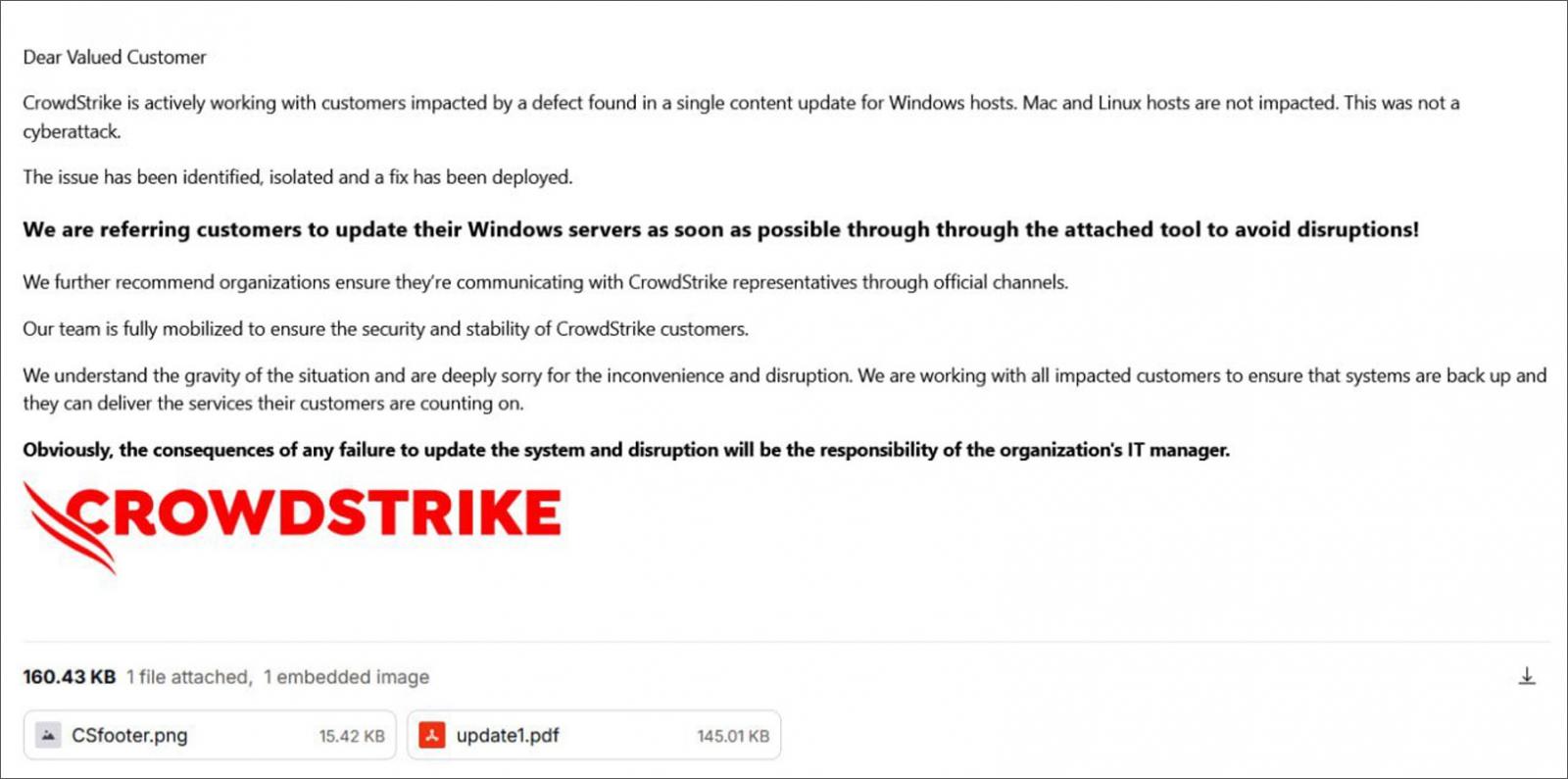Threat actors are exploiting the massive business disruption from CrowdStrike’s glitchy update on Friday to target companies with data wipers and remote access tools.
As businesses are looking for assistance to fix affected Windows hosts, researchers and government agencies have spotted an increase in phishing emails trying to take advantage of the situation.
Official channel communication
In an update today, CrowdStrike says it “is actively assisting customers” impacted by the recent content update that crashed millions of Windows hosts worldwide.
The company advises customers to verify that they communicate with legitimate representatives through official channels since “adversaries and bad actors will try to exploit events like this.”
“I encourage everyone to remain vigilant and ensure that you’re engaging with official CrowdStrike representatives. Our blog and technical support will continue to be the official channels for the latest updates” – George Kurtz, CrowdStrike CEO
The U.K. National Cyber Security Center (NCSC) also warned that it observed an increase in phishing messages aiming to take advantage of the outage.
Automated malware analysis platform AnyRun noticed “an increase in attempts at impersonating CrowdStrike that can potentially lead to phishing” [1, 2, 3].
Malware cloaked as fixes and updates
On Saturday, cybersecurity researcher g0njxa first reported a malware campaign targeting BBVA bank customers that offered a fake CrowdStrike Hotfix update that installs the Remcos RAT.
The fake hotfix was promoted through a phishing site, portalintranetgrupobbva[.]com, which pretended to be a BBVA Intranet portal.
Enclosed in the malicious archive are instructions telling employees and partners to install the update to avoid errors when connecting to the company’s internal network.
“Mandatory update to avoid connection and synchronization errors to the company’s internal network,” reads the ‘instrucciones.txt’ file in Spanish.
AnyRun, who also tweeted about the same campaign, said that the fake hotfix delivers HijackLoader, which then drops the Remcos remote access tool on the infected system.

Source: AnyRun
In another warning, AnyRun announced that attackers are distributing a data wiper under the pretense of delivering an update from CrowdStrike.
“It decimates the system by overwriting files with zero bytes and then reports it over #Telegram,” AnyRun says.
This campaign was claimed by the pro-Iranian hacktivist group Handala, who stated on Twitter that they impersonated CrowdStrike in emails to Israeli companies to distribute the data wiper.
The threat actors impersonated CrowdStrike by sending emails from the domain’ crowdstrike.com.vc,’ telling customers that a tool was created to bring Windows systems back online.

The emails include a PDF seen by BleepingComputer that contains further instructions on running the fake update, as well as a link to download a malicious ZIP archive from a file hosting service. This zip file contains an executable named ‘Crowdstrike.exe.’

Source: BleepingComputer
Once the fake CrowdStrike update is executed, the data wiper is extracted to a folder under %Temp% and launched to destroy data stored on the device.
Millions of Windows hosts crashed
The defect in CrowdStrike’s software update had a massive impact on Windows systems at numerous organizations, making it too good an opportunity for cybercriminals to pass.
According to Microsoft, the faulty update “affected 8.5 million Windows devices, or less than one percent of all Windows machines.”
The damage happened in 78 minutes, between 04:09 UTC and 05:27 UTC.
Despite the low percentage of affected systems and CrowdStrike’s effort to correct the issue quickly, the impact was huge.
Computer crashes led to thousands of flights being canceled, disrupted activity at financial companies, brought down hospitals, media organizations, railways, and even impacted emergency services.
In a post-mortem blog post on Saturday, CrowdStrike explains that the cause of the outage was a channel file (sensor configuration) update to Windows hosts (version 7.11 and above) that triggered a logic error leading to a crash.
While the channel file responsible for the crashes has been identified and no longer causes problems, companies that still struggle to restore systems to normal operations can follow CrowdStrike’s instructions to recover individual hosts, BitLocker Keys, and cloud-based environments.

